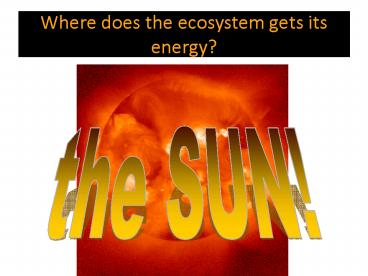Where does the ecosystem gets its energy? - PowerPoint PPT Presentation
1 / 16
Title:
Where does the ecosystem gets its energy?
Description:
Where does the ecosystem gets its energy? Photosynthesis The basics: Energy from light is used to convert CO2, and H2O into sugar O2 is a byproduct or leftover ... – PowerPoint PPT presentation
Number of Views:37
Avg rating:3.0/5.0
Title: Where does the ecosystem gets its energy?
1
Where does the ecosystem gets its energy?
the SUN!
2
Photosynthesis
3
The basics
- Energy from light is used to convert CO2, and H2O
into sugar - O2 is a byproduct or leftover and is released
- Photosynthesis
- 6CO26H2OEnergy ? C6H12O66O2
4
- Photosynthesis is an endothermic process takes
place in the chloroplasts of the leaves. - The food made by plants is called
- carbohydrates (glucose) or sugar.
- It may be stored in the roots, fruits or the
seeds. - It may be used for energy
- in the growing parts of the plant, like the buds.
- Photosynthesis
- Photo refers to light.
- Synthesis means the building of a
- complex substance from simpler substances.
5
The rate of photosynthesis
1) The lower the temperature, the slower the
photosynthesis.
2) When the amount of light decreases, or the
amount of CO2 decrease, the rate of
photosynthesis also decreases
6
Cellular Respiration
7
Basically
- Carbon dioxide is returned to the atmosphere by
cellular respiration, which is done by
heterotrophs like us. - It is an exothermic reaction because it releases
energy. - Cellular Respiration is the opposite of
photosynthesis C6H12O6 6O2 ? 6CO2 6H2O
ATP - ATP is energy
- This process happens in the mitochondria of cells.
8
Both Processes are Linked Through The Carbon Cycle
9
Carbon Cycle
COPY DOWN!
10
(No Transcript)
11
Summary of the Carbon cycle
- The reactants of photosynthesis are the products
of cellular respiration, and the products of
photosynthesis are the reactants of cellular
respiration. - Photosynthesis stores energy in sugar molecules,
and cellular respiration breaks the bonds in the
sugar molecule to release that energy.
12
Reservoirs for carbon dioxide
- The chief reservoirs for carbon dioxide are the
oceans and in rock. - CO2 is soluble (dissolves) in water and can
react with minerals (Ca) to form rock
13
What happens to the Carbon?
- Plants take up carbon dioxide and the carbon now
has 3 possible fates (i) it can be released to
the atmosphere by the plant through respiration
(ii) it can be eaten by an animal (iii) it can
be present in the plant when the plant dies - Animals obtain all their carbon from their food,
so all carbon in biological systems ultimately
comes from plants (autotrophs). In the animal,
the carbon has the same 3 possible fates as in
plants.
14
The Carbon Cycle in Action
- Carbon in the atmosphere will either be taken up
by a plant in photosynthesis or dissolved in the
oceans. - When an animal or a plant dies, the carbon can
either be respired by decomposers (and released
to the atmosphere), or it can be buried intact
and ultimately form coal, oil, or natural gas
(fossil fuels). - Humans have a great impact on the carbon cycle
because when we burn fossil fuels, more is carbon
dioxide present in the atmosphere which causes
global warming.
15
(No Transcript)
16
(No Transcript)































